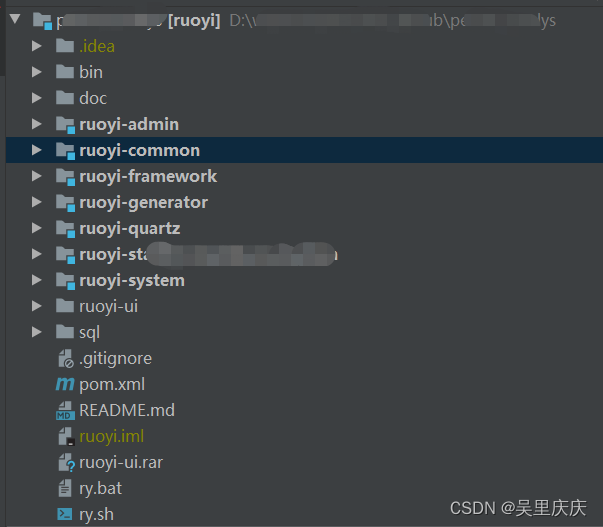系统说明(两个系统数据库用户信息username是同步的,都是唯一的)
- 第三方平台
- 若依系统(ruoyi分离版)
登录需求:
我登录到第三方平台,第三方平台嵌入我们的若依,所以在跳若依的管理页面时不想再登录了。但是验证是需要把第三方平台的token解析成username,拿到username只走我们自己只验证账号的认证。(默认是用户名+密码)
实现构想:
通过前端新加一个页面没有任何样式,只接收第三方平台传来的token,拿到token请求我们自定义的登录controller解析到对应的用户名,直接走用户名认证,认证成功返回生成的jwtToken。前端的新页面拿到请求成功的jwtToken后直接延用原来登录的逻辑跳转到若依的首页!
待优化:
拿到第三方平台的token可以再请求下第三方的接口验证对方的token是否有效。如果该账号在若依不存在可以在请求第三方时 获取对方的账号部门信息新建一个。(是防止对方传过来的token被多次使用,因为双方token过期时间不一致)
项目目录结构:(给个大概,截图太累了)

代码实现(全部在若依端进行改造)
- login.js中添加 (请求后端接口)
export function ywgllogin(data) {
return request({
url: '/ywgllogin',
method: 'post',
data: data
})
}
-
user.js中添加(引用组件,添加方法)

//ywgl通过它自己的accessToken登录
YwglLogin({ commit }, data) {
return new Promise((resolve, reject) => {
ywgllogin(data).then(res => {
setToken(res.token)
commit('SET_TOKEN', res.token)
resolve()
}).catch(error => {
reject(error)
})
})
},- index.js中添加
{
path: '/ywgllogin',
component: () =>
import ('@/views/ywgllogin'),
hidden: true
},- views下面同原来login.vue同级新建ywgllogin.vue
<template>
<div>ywgl跳转登录中...</div>
</template>
<script>
export default {
name: "YwglLogin",
data() {
return {
loginRules: {},
loginForm: {
username: "",
password: "",
rememberMe: false,
code: "",
uuid: "",
},
loading: false,
// 验证码开关
captchaOnOff: true,
// 注册开关
register: false,
redirect: undefined,
};
},
watch: {
$route: {
handler: function (route) {
this.redirect = route.query && route.query.redirect;
},
immediate: true,
},
},
created() {
//平台单独的登录 2022年4月19日11:23:58
this.getLoginByNameAndTokenJ();
},
methods: {
/**
* 三方平台单点登陆系统 2022年4月19日11:22:33
* 只传递token
*/
getLoginByNameAndTokenJ() {
//获取地址栏中的token
var accessToken = this.$route.query.accessToken;
//调用登录的接口
if (accessToken == "" || accessToken == undefined || accessToken == null) {
//不是那边系统过来的,不走这个地方(阻止created的方法继续向下走)
this.$message.error("用户token为空");
} else {
//转圈圈,不要看到登陆页面,无感体验
this.loading = true;
var logininfo = {
accessToken: accessToken,
};
//执行另一套登录操作
//不是本系统的用户,去J平台登陆去
this.$store
.dispatch("YwglLogin", logininfo)
.then(() => {
//this.$message.success("登录成功");
this.loading = false;
this.$router.push({ path: this.redirect || "/" }).catch(() => {});
})
.catch((err) => {
console.log("有异常信息", err);
//异常信息
this.loading = false;
// if (this.captchaOnOff) {
// this.getCode();
// }
});
}
},
},
};
</script>
<style rel="stylesheet/scss" lang="scss">
</style>
- permission.js添加白名单放行(两处)
const whiteList = ['/ywgllogin','/login', '/auth-redirect', '/bind', '/register']
if (to.path === '/login'||to.path === '/ywgllogin') {
- 后端登录新接口(controller)
package com.ruoyi.web.controller.system;
import com.ruoyi.common.constant.Constants;
import com.ruoyi.common.core.domain.AjaxResult;
import com.ruoyi.common.core.domain.model.LoginBody;
import com.ruoyi.common.utils.StringUtils;
import com.ruoyi.framework.web.service.YwglTokenService;
import com.ruoyi.system.service.ISysUserService;
import org.springframework.beans.factory.annotation.Autowired;
import org.springframework.web.bind.annotation.PostMapping;
import org.springframework.web.bind.annotation.RequestBody;
import org.springframework.web.bind.annotation.RestController;
/**
* 登录验证
*
* @author qwu
*/
@RestController
public class YwglAccessTokenLoginController {
@Autowired
private ISysUserService sysUserService;
@Autowired
private YwglTokenService ywglTokenService;
/**
* 登录方法
*
* @return 结果
*/
@PostMapping("/ywgllogin")
public AjaxResult ywgllogin(@RequestBody LoginBody loginBody) {
String accessToken = loginBody.getAccessToken();
if (StringUtils.isNotEmpty(accessToken)) {
String tokenNew = ywglTokenService.ywglLogin(accessToken);
AjaxResult ajax = AjaxResult.success();
ajax.put(Constants.TOKEN, tokenNew);
return ajax;
} else {
return AjaxResult.error();
}
}
}
注意:LoginBody新增变量accessToken
- service添加登录验证走自己的
public String ywglLogin(String accessToken)
{
// 用户验证
Authentication authentication = null;
String username =accessToken;
try
{
username="这里填自己如何解析我们第三方传来的accessToken变成系统的username这里我就省略了";
authentication = authenticationManager
.authenticate(new YwglAuthenticationToken(username));
}
catch (Exception e)
{
if (e instanceof BadCredentialsException)
{
AsyncManager.me().execute(AsyncFactory.recordLogininfor(username, Constants.LOGIN_FAIL, MessageUtils.message("user.password.not.match")));
throw new UserPasswordNotMatchException();
}
else
{
AsyncManager.me().execute(AsyncFactory.recordLogininfor(username, Constants.LOGIN_FAIL, e.getMessage()));
throw new ServiceException(e.getMessage());
}
}
AsyncManager.me().execute(AsyncFactory.recordLogininfor(username, Constants.LOGIN_SUCCESS, MessageUtils.message("user.login.success")));
LoginUser loginUser = (LoginUser) authentication.getPrincipal();
recordLoginInfo(loginUser.getUserId());
// 生成token
return tokenService.createToken(loginUser);
}- 添加自定义认证 YwglAuthenticationToken
package com.ruoyi.framework.ywglsecurity;
import org.springframework.security.authentication.AbstractAuthenticationToken;
import org.springframework.security.core.GrantedAuthority;
import java.util.Collection;
public class YwglAuthenticationToken extends AbstractAuthenticationToken {
private final Object principal;
public YwglAuthenticationToken(Object principal) {
super(null);
this.principal = principal;
this.setAuthenticated(false);
}
public YwglAuthenticationToken(Object principal, Collection<? extends GrantedAuthority> authorities) {
super(authorities);
this.principal = principal;
super.setAuthenticated(true);
}
@Override
public Object getCredentials() {
return null;
}
@Override
public Object getPrincipal() {
return this.principal;
}
@Override
public void setAuthenticated(boolean isAuthenticated) throws IllegalArgumentException {
if (isAuthenticated) {
throw new IllegalArgumentException(
"Cannot set this token to trusted - use constructor which takes a GrantedAuthority list instead");
}
super.setAuthenticated(false);
}
@Override
public void eraseCredentials() {
super.eraseCredentials();
}
}
- 添加 YwglAuthenticationProvider
package com.ruoyi.framework.ywglsecurity;
import com.ruoyi.framework.web.service.UserDetailsServiceImpl;
import org.springframework.beans.factory.annotation.Autowired;
import org.springframework.security.authentication.AuthenticationProvider;
import org.springframework.security.core.Authentication;
import org.springframework.security.core.AuthenticationException;
import org.springframework.security.core.userdetails.UserDetails;
import org.springframework.stereotype.Component;
import java.util.Collections;
@Component
public class YwglAuthenticationProvider implements AuthenticationProvider {
@Autowired
private UserDetailsServiceImpl userDetailsService;
/**
* 认证逻辑
*/
@Override
public Authentication authenticate(Authentication authentication) throws AuthenticationException {
YwglAuthenticationToken ywglAuthenticationToken = (YwglAuthenticationToken) authentication;
String username = (String) ywglAuthenticationToken.getPrincipal();
UserDetails user = userDetailsService.loadUserByUsername(username);
YwglAuthenticationToken result = new YwglAuthenticationToken(user, Collections.emptyList());
/*
Details 中包含了 ip地址、 sessionId 等等属性 也可以存储一些自己想要放进去的内容
*/
result.setDetails(ywglAuthenticationToken.getDetails());
return result;
}
/**
*UserIdAuthenticationToken交给UserIdAuthenticationProvider处理
* @param aClass
* @return
*/
@Override
public boolean supports(Class<?> aClass) {
return YwglAuthenticationToken.class.isAssignableFrom(aClass);
}
}
- 修改SecurityConfig 放行我们的请求登录路径 并把自定义认证加进来
.antMatchers("/hello","/ywgllogin","/login", "/register", "/captchaImage").anonymous()
@Override
protected void configure(AuthenticationManagerBuilder auth) throws Exception
{
auth.userDetailsService(userDetailsService).passwordEncoder(bCryptPasswordEncoder());
auth.authenticationProvider(ywglAuthenticationProvider);
}
主要参考:
若依 Spring Security 自定义认证集成_高德新的博客-CSDN博客_若依 认证
若依实现系统单点登录(可绕过验证码)_穆雄雄的博客-CSDN博客
最后
以上就是尊敬大炮最近收集整理的关于若依ruoyi实现单点登录的全部内容,更多相关若依ruoyi实现单点登录内容请搜索靠谱客的其他文章。
本图文内容来源于网友提供,作为学习参考使用,或来自网络收集整理,版权属于原作者所有。








发表评论 取消回复